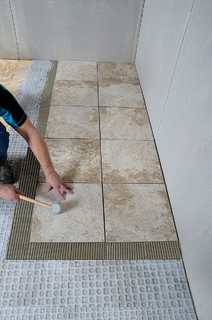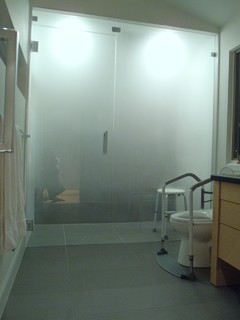Why Bathroom Floors Need to Move
 Wednesday, August 28, 2013 at 8:50AM
Wednesday, August 28, 2013 at 8:50AM Article By: John Whipple
"Tenting" is a terrible word to a tile professional. When a bathroom floor has been installed incorrectly, tiles can press against one another and pop up off the floor, creating a tent shape. It's not just tile that does this — almost every material in a home expands and contracts with time, including the plywood subfloor, which can develop popped tiles or cracked grout joints.
These professional pointers for preparation and installation techniques can help keep your bathroom floor from tenting.
Avoid large-format tile. More grout joints allow for minor movement and spreading out.
If you have a large bathroom — like this beautiful space — with loads of natural sunlight, a smaller and lighter tile is definitely a safer option. Darker tile absorbs heat and expands and contracts more than lighter tile.
All of a home's building materials expand and contract; the hardwood floor, the tile and even the countertops all move over time. Any good pro should know how to account for these size changes and prevent expansion from wreaking havoc in a home.
Tip: Make sure your tongue and groove subfloor does not get filled with dust, debris or adhesive mortar (thinset). This subfloor needs the ability to move, and the joints should not be too tight.
This photo shows some great tile work. The beautiful tile is nicely lined up, but I especially appreciate how there's no mortar or thinset where the tile meets the wall. Using mortar here can lead to tenting issues, since it prevents the tile floor from moving and expanding. This clean finish is exactly what you want to see in your bathroom. Make sure your tile contractor understands that you don't want your installation done with thinset on the edges that meet the wall.
If you drive over bridges frequently — like I do every day — you'll notice that bridges have expansion strips. During the summer the bridge is quiet, since summer's heat has expanded the bridge's concrete and the expansion strips are pressed tight. But in the winter, driving over the same bridge sounds quite different; the expansion strips are wider, and they click-clack as your tires hit them.
Designing tile floors to expand and contract follows some of these same principles. Uncoupling membranes underneath floor tile can improve your floor's flexibility. This photo shows a professional installing a Strata Matuncoupling membrane to account for minor floor movement.
Hearing a hollow noise when you're walking across newly tiled floors could be the early signs of tile bond failure. This sound results from poor thinset coverage.
In this photo the floor tile goes underneath the tub skirt. This is a solid design that allows for movement on the floor tile.
Tip: Gently tapping set tiles with the wooden handle of a rubber mallet can help you find the hollow noise where poor thinset coverage has occurred.
All steam showers have a modified thinset to account for quick thermal expansion. The powerful steam and heat in steam showers require a thinset that can accommodate immediate expansion and contraction.
Glass expands more than many other building materials. Large panels like these let in lots of sunshine and quickly heat up the bathroom, increasing thermal expansion.
For an installation like this, I'd make sure that the corners of the shower stall had two layers of a waterproofing membrane. Products like NobleSeal TShave a thicker membrane that can take some compression in the corners.
With extremely large bathrooms, expansion strips inlayed into the tile assembly are a must. In my opinion, any room larger than 15 feet in one direction should be using some kind of expansion strip and speciality thinsets and grouts to increase expansion and combat mortar fatigue.
 Floors,
Floors,  Tile in
Tile in  Backsplash,
Backsplash,  Flooring,
Flooring,  Remodeling Resources
Remodeling Resources 
























Reader Comments (1)
I appreciate it which provided awareness about renovation.. I would like to sell my house after read this article i think that I should sell my house after renovation...Because of it i can add the value and unique design of home...
Thanks for provided me great tips about renovation...